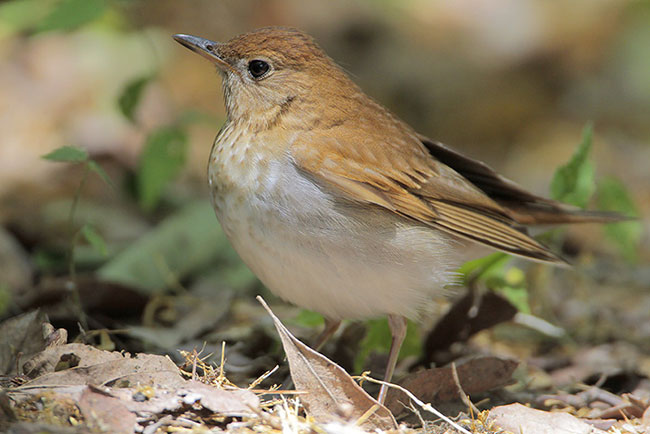The Veery is a medium-sized thrush. They have round heads, plump bodies, fairly long legs, wings, and narrow, straight bills.
This small thrush gets its name from the cascade of “veer” notes that make up its song. It’s a common sound in the northern damp woods at dawn and dusk in the summer.
Veeries hop through the understory as they forage for fruit and insects. They spend their winters in South America. Learning its downward-spiraling, haunting song is a great way to find this bird.
Upon locating one or more of these singing birds, walk slowly, and observe for birds perched in the mid or upper canopy.
On this page
Identification
Adult male Veeries are bright cinnamon-brown overall and have indistinct spotting on the chest. Additionally, their underparts are pale, their threats are white, and they have a buffy-orange cast. Female Veeries look identical to male Veeries.
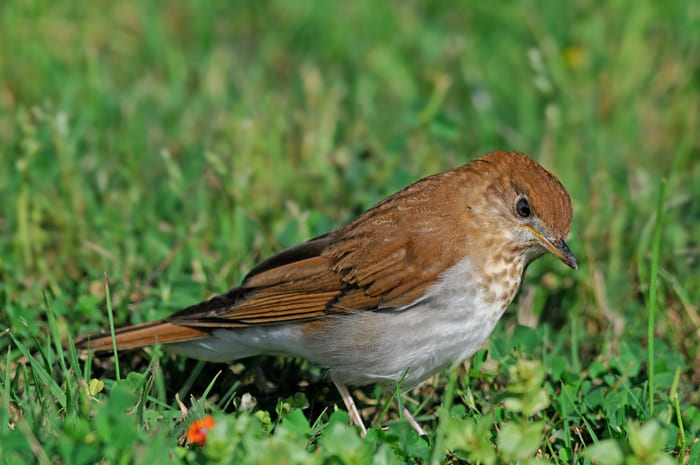
These birds are 6.7 to 7.1 inches (17 to 18 centimeters), weigh 1.0 to 1.9 ounces (28 to 54 grams), and have a wingspan of 11.0 to 11.4 inches (28 to 29 centimeters). They’re smaller than an American Robin and larger than a Song Sparrow.
Veeries that breed in the far-western portion of their range and Newfoundland tend to have darker lateral throat lines, more distinct chest spotting, and darker brown above. However, few individuals may be as dark as Gray-cheeked Thrush or Swainson’s Thrush on the upper parts.
Food
Veeries primarily consume invertebrates, including insects, during the breeding season. Then, they switch to consuming mainly fruit in late summer and fall.
Prey includes ants, beetles, wasps, grasshoppers, caterpillars, flies, salamanders, and frogs.
They’ll consume honeysuckle, juneberries, strawberries, wild cherries, blackberries, blueberries, dogwood and sumac fruits, elderberries, and wild grapes.
Nesting and Eggs
Veeries usually create their nests near or on the ground. Nests are almost never higher than 5 feet. The nest may be placed in soft vegetation like a clump of grass, under debris and brush, against a fallen branch, trunk, or a mossy hummock. Some of their nests are found on dry, high hillsides.
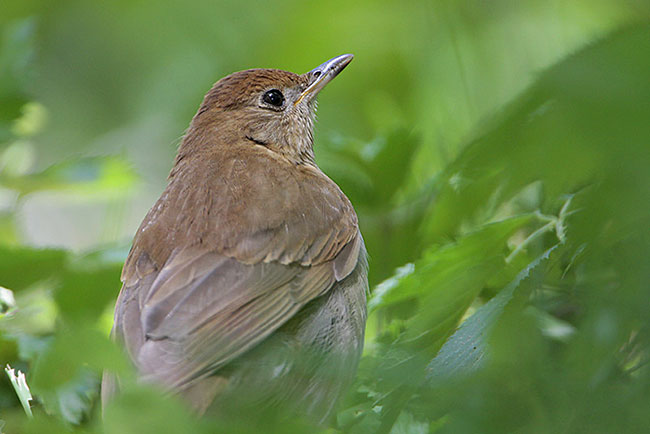
The female Veery is the one to make the nest. It takes around 6 to 10 days while the male guards their territory. First, she’ll begin by making a platform out of dead leaves. Next, she’ll add decomposing, wet leaves; weed stems, and grapevine bark.
After, she lines the nest with fine fibers like rootlets, continually changing her position as she compacts the material so the nest is evenly shaped. The completed nest has an external diameter of 3 to 6 inches and an external height of 3.5 to 5.5 inches. The interior of the nest is 2 to 3 inches wide and 1 to 2.5 inches tall.
- The clutch size is 1 to 5 eggs.
- Veeries have 1 to 2 broods per breeding season.
- Egg length can be anywhere from 0.8 to 1.0 inches (2.1 to 2.5 centimeters).
- Egg width can be anywhere from 0.6 to 0.7 inches (1.6 to 1.8 centimeters).
- The incubation period is 10 to 14 days.
- The nestling period is 10 to 12 days.
- Eggs are greenish blue and are occasionally spotted with brown.
Current Situation
Veeries have experienced significant but slow declines over the 50 years. However, these birds are still common in the wood of the north. According to the IUCN Red List, their population is decreasing, but they are still a species of low concern.
Some causes of their decline may be the rapid transformation of their South American winter habitats from forests to agricultural land. Their northern breeding habitats are also being fragmented or destroyed. The clearing of the dense understory and increased understory browsing by white-tailed deer can also be detrimental.
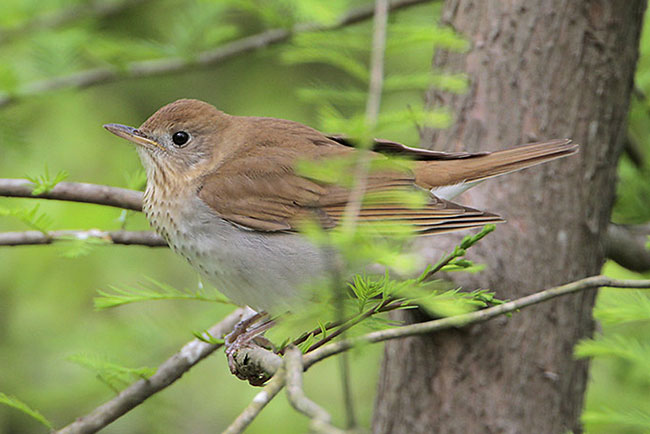
The Veery breeds in damp, dense, mostly deciduous woodlands. They often inhabit areas near swampy areas, streams, and rivers. Breeding habitat includes forests of maple, oak, cherry, birch, aspen, alder, fir, and spruce, among other shrubs and trees.
Veeries prefer disturbed forests with dense understory because it provides protection for their nests. During the spring and fall migration, they favor second-growth woodlands and forest edges.
Facts
- The oldest recorded Veery lived to be at least 13 years old. He was a banded male who researchers recaptured and rereleased during banding operations in 2010 in Delaware.
- A migration study of these birds use radio telemetry that showed that these birds can fly up to 160 mi (285 kilometers) in a single night and are able to fly at altitudes above 1.2 miles (2,000 meters).
- Both other songbirds, along with veeries, migrate for long periods at night. Many of these birds alternate between coasting and flapping, but Veeries flap consistently throughout their night flight. Their wings are efficient and can carry them over farther routes that other thrushes couldn’t handle.
- It’s common for Veery nests to include Brown-headed Cowbird eggs. Veery parents either don’t recognize or tolerate both young and eggs. One study found that adult Veeries protected a fledgling that was not their own that was attacked by a snake.
Similar Species
The Veery has features that are similar to other bird species. Here are some similar species:
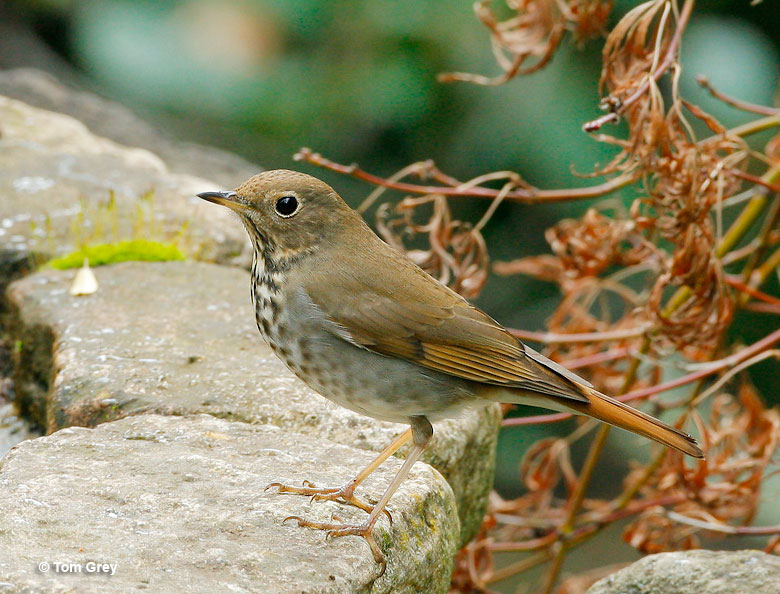
Hermit Thrush
The Veery is uniformly brown, while Hermit Thrushes are duller brown above and have cinnamon tails.
Also, Hermit Thrushes slowly lower and quickly raise their tails, which no other thrush does.
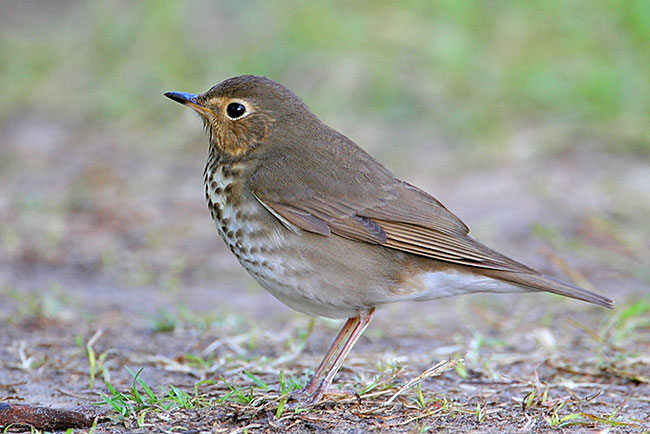
Swainson’s Thrush
The Veery is lighter than the Swainson’s Thrush. Swainson’s Thrushes are a dark olive-brown on the tail and back.
They also have bolder spots on the breast and big buffy eyerings that Veeries don’t have.
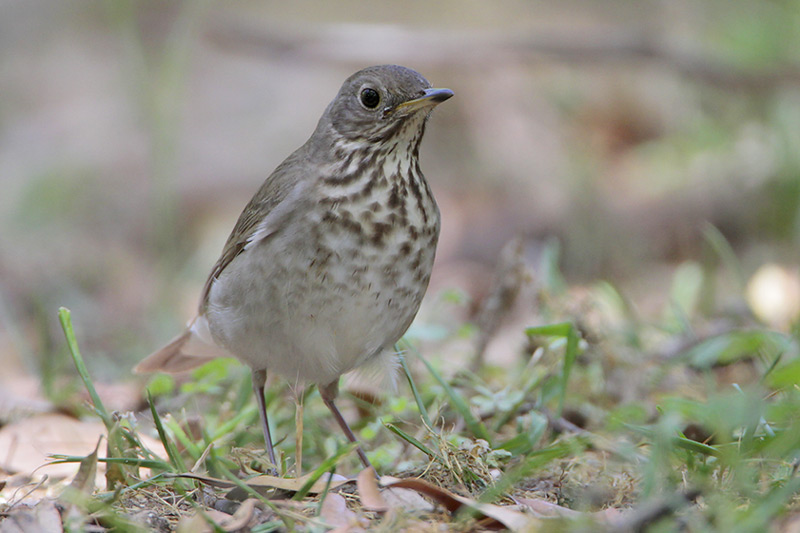
Gray-cheeked Thrush. Photograph © Greg Lavaty.
Gray-cheeked Thrushes don’t have the reddish-brown tones that Veeries do.
Additionally, Gray-cheeked Thrushes are gray overall.
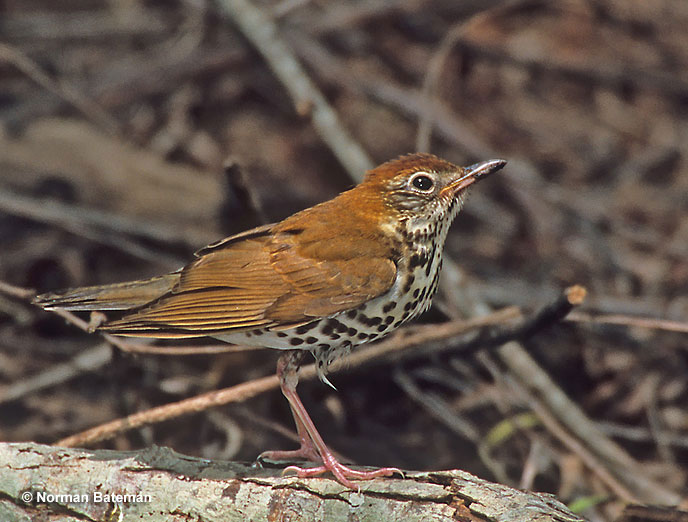
Wood Thrush
The Veery is thinner and smaller than Wood Thrushes.
Additionally, Wood Thrushes have distinctive spotting on the belly and chest.
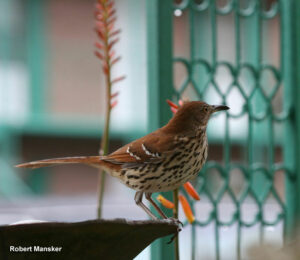
Brown trasher
The Veery is plumper and smaller than a Brown Thrasher.
Additionally, Brown Thrashers have yellow eyes, longer bills, longer tails, and extensive streaking on the belly.
Frequently Asked Questions
What kind of bird is a Veery?
Veeries are medium-sized thrush. They’re smaller than an American Robin and larger than a Song Sparrow.
What do Veeries eat?
Veeries primarily consume invertebrates, including insects, during the breeding season. Then, they switch to consuming mainly fruit in late summer and fall. Prey includes ants, beetles, wasps, grasshoppers, caterpillars, flies, salamanders, and frogs. Fruits they’ll consume are honeysuckle, juneberries, strawberries, wild cherries, blackberries, blueberries, dogwood and sumac fruits, elderberries, and wild grapes.
What is the range of the Veery?
Veeries can be found in most of the United States, Canada, Mexico, the Caribbean, Central America, and South America. Nearly all birds migrate from their breeding grounds in the northern U.S. and Canada to their wintering grounds in South America.
What is the sound of a Veery?
The Veery has a song that slightly descends in pitch and resonates. Additionally, these birds emit a variety of squealed, chattering and whistled calls. The most common call is a short, distinctive jeer or veer note that can make veeries easy to find even when they’re not singing.

